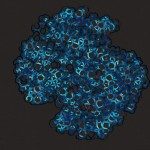Link to Pubmed [PMID] – 16199575
J. Bacteriol. 2005 Oct;187(20):7045-55
Pullulanase (PulA) from the gram-negative bacterium Klebsiella oxytoca is a 116-kDa surface-anchored lipoprotein of the isoamylase family that allows growth on branched maltodextrin polymers. PulA is specifically secreted via a type II secretion system. PelBsp-PulA, a nonacylated variant of PulA made by replacing the lipoprotein signal peptide (sp) with the signal peptide of pectate lyase PelB from Erwinia chrysanthemi, was efficiently secreted into the medium. Two 80-amino-acid regions of PulA, designated A and B, were previously shown to promote secretion of beta-lactamase (BlaM) and endoglucanase CelZ fused to the C terminus. We show that A and B fused to the PelB signal peptide can also promote secretion of BlaM and CelZ but not that of nuclease NucB or several other reporter proteins. However, the deletion of most of region A or all of region B, either individually or together, had only a minor effect on PelBsp-PulA secretion. Four independent linker insertions between amino acids 234 and 324 in PelBsp-PulA abolished secretion. This part of PulA, region C, could contain part of the PulA secretion signal or be important for its correct presentation. Deletion of region C abolished PelBsp-PulA secretion without dramatically affecting its stability. PelBsp-PulA-NucB chimeras were secreted only if the PulA-NucB fusion point was located downstream from region C. The data show that at least three regions of PulA contain information that influences its secretion, depending on their context, and that some reporter proteins might contribute to the secretion of chimeras of which they are a part.

